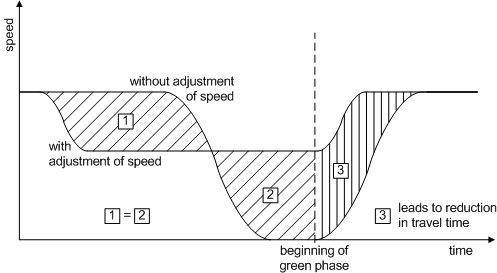
 |
Geschwindigkeitsvorgabe an LichtsignalanlagenTechnische Aspekte und volkswirtschaftlicher NutzenDissertation - vorgelegt von Andreas Richter |
|
Home Kurzfassung Abstract Hilfsmittel Kontakt 
|
Abstract In order to allow for more free flowing traffic and to reduce idle times, the signal programs from traffic lights are currently governed online by use of different methods. These have been implemented since the beginning of the 80's in urban traffic control systems (UTC systems), for example Scoot, which operates very successfully. The goal of this dissertation is to analyse how varying traffic flow speed can yield an additional improvement to the flow of traffic. One input requirement is that any interference with the signal programs of the traffic lights is not allowed. In addition, the system should be capable of interacting with existing UTC systems. The following example illustrates the basis of the novel GeVor-System*: 
A vehicle drives toward a traffic light at constant speed until it has to break due to a red light. After stopping for a specific time interval, it accelerates until it has reached its target speed again. Alternatively, if the driver brakes earlier, the driver will reach the traffic light later, possibly at the beginning of the green phase. Thus, a lower acceleration is needed because the speed difference up to the target speed is lower. In this fashion, fuel savings as a result of lessened acceleration will be possible. The algorithms and effects of such an appropriately configured controlled adjustment of speed at traffic lights are of substantial interest in the context of this dissertation. Here, an economic evaluation of the novel GeVor-System takes place alongside the technical analysis. The GeVor-System reduces the fuel consumption and the emission of exhaust gases. In addition the system lessens the risk of traffic accidents by improved traffic flow with substantially reduced numbers of full stops. All these improvements also lead to an economic benefit. Under good conditions, these benefits amount to a total of 25 000 BC per year and carriageway, as demonstrated on an existing double lane carriageway with traffic lights leading into in the city of Hamburg. *GeVor, abbreviation for Geschwindigkeitsvorgabe, German for adjustment of speed |